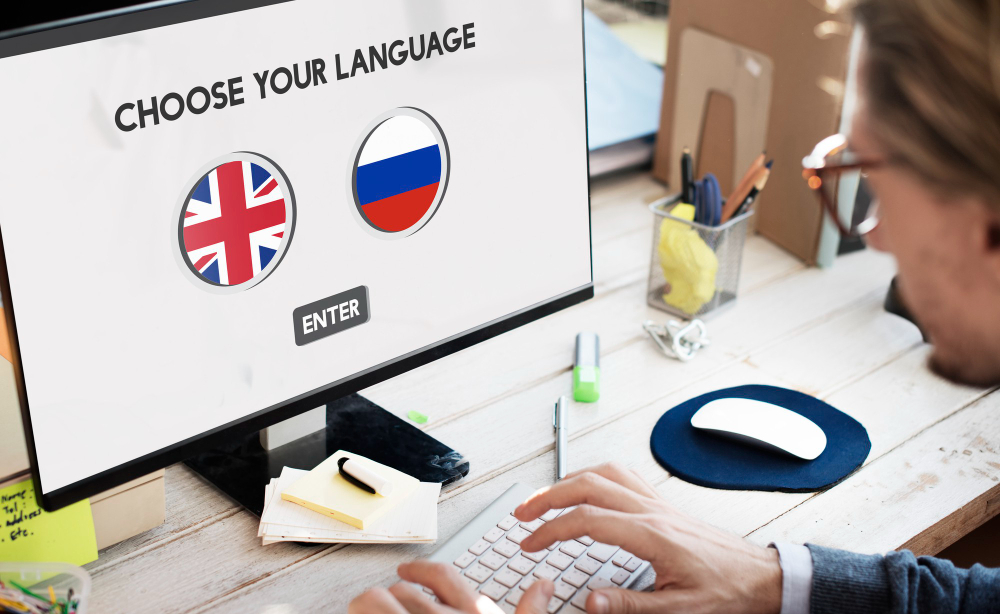Going Beyond Borders: Why Media Localization Matters for Reaching a Worldwide Audience
Nov 09, 2023, Nishi SinghWelcome to a world where borders are no longer barriers to communication. In this age of globalization, the power of media knows no bounds – it has the ability to traverse oceans and bridge cultures effortlessly. But here's the catch: if you want your message to truly resonate with a worldwide audience, you need more than just translation; you need media localization. So, buckle up as we embark on an exciting journey exploring why media localization is an absolute game-changer in reaching audiences across borders, breaking down language barriers like never before. Get ready to discover how this transformative process can take your content from being merely understood to deeply appreciated by people around the globe!
Introduction to Media Localization and its Importance
In today's digital age, media has become a powerful tool for communication and entertainment. With the internet connecting people from all corners of the world, the need for media localization has become increasingly important. Media localization refers to the process of adapting media content such as films, TV shows, video games, and advertisements to suit the linguistic, cultural, and technical requirements of a specific target audience.
The importance of media localization cannot be overstated when it comes to reaching a worldwide audience. In order to effectively communicate with audiences from different cultures and languages, it is crucial for companies and content creators to localize their media content. This not only ensures that their message is understood accurately but also helps in building a strong connection with the viewers.
One of the key reasons why media localization matters is because it allows companies to expand their reach and tap into new markets. By localizing their content, businesses can break language barriers and connect with potential customers who may not have been able to access their content otherwise. This helps in creating brand awareness globally and can lead to increased sales and revenue for companies.
Moreover, media localization also plays an important role in promoting cultural understanding. In today's diverse society where people from different backgrounds coexist, it is essential for media content to be culturally sensitive and inclusive. By localizing their content, companies can ensure that their message does not get lost in translation or offend anyone due to cultural differences. This promotes positive representation of diverse cultures on a global platform.
Understanding Cultural Differences in Global Audiences
In today's interconnected world, media has the power to reach audiences globally. With the rise of technology and social media platforms, content creators have a larger audience than ever before. However, with this increased reach comes the challenge of understanding cultural differences in global audiences.
Cultural differences play a significant role in how individuals perceive and interpret information presented to them. These differences can range from language barriers to societal norms and values. As such, it is crucial for content creators to understand these nuances when targeting a worldwide audience.
One major aspect to consider when localizing media for global audiences is language. While English may be considered the universal language for business and trade, it is not necessarily the primary language for all countries. Therefore, translating content into other languages allows for more inclusivity and accessibility to non-English speaking audiences.
However, simply translating words does not guarantee effective communication with diverse cultural groups. It is essential to also consider cultural nuances that may affect how messages are perceived by different audiences. For example, certain words or phrases may have different meanings or connotations in different cultures. Therefore, localization involves adapting content not just linguistically but also culturally.
Another crucial factor in understanding cultural differences is familiarity with local customs and traditions. This includes an awareness of religious practices, holidays, historical events, and social norms within specific regions or countries. By understanding these aspects of culture, media can avoid unintentionally causing offense or misunderstanding among its audience.
The Role of Media Localization in Communicating Effectively
Media localization plays a crucial role in effectively communicating with a global audience. It involves adapting content, whether it be written, audio or visual, to suit the cultural and linguistic preferences of different regions. This process goes beyond simply translating words into another language; it also takes into account the unique customs, norms and values of a particular culture.
One of the main reasons why media localization is necessary for effective communication is that it allows for better understanding and connection with the target audience. By localizing content, companies can ensure that their message is not lost in translation or misinterpreted due to cultural differences. For example, using colloquialisms in one language might not have the same impact or meaning when translated into another language. By taking this into consideration and adapting content accordingly, media localization helps bridge any potential communication gaps.
Moreover, media localization also shows respect towards different cultures by acknowledging their specific needs and preferences. In today's globalized world, audiences are increasingly diverse and have varying levels of familiarity with foreign languages. Localizing content makes it more accessible to these audiences and shows that companies are invested in reaching out to them on a personal level.
Additionally, media localization also has practical benefits when it comes to marketing strategies. Studies have shown that consumers are more likely to purchase products or services if they are marketed in their native language and tailored to their cultural context. This highlights the importance of media localization as a tool for businesses looking to expand their reach globally.
Benefits of Media Localization for Businesses and Brands
In today's interconnected world, businesses and brands are constantly looking for ways to expand their reach and tap into new markets. One of the most effective strategies for achieving this is through media localization. Media localization refers to the process of adapting content to suit a particular cultural or linguistic context, making it more relevant and relatable to a specific audience.
But what exactly are the benefits of media localization for businesses and brands? Let's take a closer look:
1. Increased Reach and Engagement
By localizing your media content, you are essentially breaking down language barriers and making your brand accessible to a wider audience. This can open up new markets for your business, helping you reach potential customers who may have previously been unable to engage with your content due to language barriers. By catering to the specific cultural nuances of different regions, you also increase the likelihood of engaging with your target audience on a deeper level.
2. Improved Brand Perception
Media localization shows that your brand values diversity and is willing to go above and beyond in order to connect with its global audience. This can help build trust among consumers from different cultures, ultimately enhancing your brand perception. In contrast, not localizing your content could potentially lead to misinterpretations or misunderstandings that could negatively impact how your brand is perceived in different regions.
3. Customization for Local Preferences
Different regions have unique preferences when it comes to media content – whether it be in terms of humor, storytelling techniques, or visual aesthetics. By localizing your content, you can tailor it to better resonate with the specific tastes and preferences of different regions. This customization can make your content more appealing and relatable to local audiences, increasing the chances of engagement and conversion.
4. Competitive Advantage
In today's globalized marketplace, businesses are constantly competing for attention and market share. By localizing your media content, you can gain a competitive edge over businesses that have not yet tapped into certain markets. This can be especially beneficial for smaller businesses looking to expand their reach without breaking the bank on extensive marketing efforts.
5. Cost-Effective Marketing Strategy
Media localization is a cost-effective way to reach new markets and engage with diverse audiences. It eliminates the need for extensive marketing campaigns targeting different regions, as localized content can effectively communicate your brand message on a deeper level.
Examples of Successful Media Localization Strategies
Media localization is the process of adapting media content to suit the cultural and linguistic preferences of a specific target audience. It involves not only translating the language, but also considering cultural nuances, local slang, and customs. In today's globalized world, media localization has become an essential strategy for companies and organizations looking to expand their reach to international markets.
In this section, we will look at some examples of successful media localization strategies adopted by various companies in different industries.
1. Netflix:
One of the most successful media localization strategies has been implemented by Netflix. As a streaming service with a worldwide presence, Netflix understands the importance of catering to diverse audiences. They have invested heavily in localizing their content by dubbing or subtitling shows and movies in different languages. For instance, they offer subtitles in more than 30 languages for their popular show "Stranger Things" and have even produced localized versions of shows such as "Narcos" which features dialogue in Spanish.
2. Coca-Cola:
Coca-Cola is another company that has mastered the art of media localization. Their “Taste the Feeling” campaign was launched globally with tailored adaptations for different countries' cultures and tastes. For example, in China, they used traditional Chinese music and imagery featuring famous landmarks like The Great Wall to appeal to the local audience.
3. McDonald's:
McDonald's is known for its localized menus around the world. In India, where beef is not consumed due to religious beliefs, McDonald’s offers a variety of vegetarian options, including the popular McAloo Tikki burger. In Japan, they have introduced the teriyaki burger and in Singapore, they offer a spicy chicken burger to cater to local tastes.
4. Disney:
Disney has successfully localized its theme parks to suit different cultures. For instance, the Shanghai Disneyland Resort features a unique Chinese-style castle and offers Chinese cuisine alongside traditional theme park food. They also have characters from popular Chinese myths and legends appearing in their shows and parades.
5. Airbnb:
Airbnb is another company that has embraced media localization as part of its expansion strategy. When entering the Chinese market, they launched a separate platform called Aibiying (爱彼迎) which means "welcome each other with love". This name was chosen to resonate with the Chinese culture of hospitality and warmth.
6. IKEA:
IKEA is known for its affordable and stylish furniture, but they also pay attention to localized marketing strategies. In Saudi Arabia, where women are not allowed to drive, IKEA created an ad campaign featuring women driving cars with iconic IKEA products strapped onto their vehicles.
Challenges and Considerations for Media Localization
When it comes to reaching a worldwide audience, media localization is a crucial factor for success. It allows content creators and businesses to effectively communicate with audiences in different parts of the world by adapting their content to suit local cultures, languages, and customs. However, while media localization has many benefits, it also comes with its own set of challenges and considerations that must be taken into account. In this section, we will explore some of the common challenges faced during the process of media localization and important considerations that should be kept in mind.
1. Cultural Differences:
One of the main challenges in media localization is navigating cultural differences. What may be acceptable or even popular in one culture may not resonate well with another. For example, humor can vary greatly from one country to another – what may be considered funny in the US might not translate well in Japan or vice versa. Similarly, gestures, symbols and colors can have completely different meanings across cultures which can impact how your content is perceived and received by your target audience.
To overcome this challenge, it's essential to research and understand the cultural nuances of your target audience before beginning the localization process. This includes understanding their values, beliefs, taboos as well as specific linguistic expressions that are unique to their culture.
2. Language Barriers:
Language barriers are perhaps one of the most obvious challenges when it comes to media localization. Translating text from one language to another requires more than just converting words – it also involves adapting sentence structure and grammar according to the
How to Implement a Successful Media Localization Strategy
Implementing a successful media localization strategy is crucial for reaching a worldwide audience and ensuring your content resonates with them. It involves translating and adapting your media content to match the cultural, linguistic, and regional nuances of different markets. This not only helps you connect with your target audience but also shows that you value their culture and language.
In this section, we will discuss the steps involved in implementing a successful media localization strategy.
1. Identify Your Target Audience: The first step towards creating an effective localization strategy is identifying your target audience. You need to have a clear understanding of who they are, where they are located, what languages they speak, and their cultural preferences. This will help you tailor your content accordingly.
2. Research Local Trends and Preferences: Once you have identified your target audience, it's important to research local trends and preferences in the regions you want to reach. This includes understanding cultural nuances, popular slang words or phrases, preferred social media platforms, etc. This information will help you create content that truly resonates with your target audience.
3. Translate Content Accurately: Translation plays a crucial role in media localization as it ensures that the meaning of the original message remains intact while being adapted for different languages. It's important to hire professional translators who are native speakers of the target language to ensure accuracy and authenticity.
4. Adapt Visuals and Design: Localization is not just limited to translating text; it also involves adapting visuals and design elements to suit different cultural preferences. For example, colors and symbols may have different meanings in different cultures, and it's important to be mindful of these when creating visuals for your localized content.
5. Localize Audio and Video Content: If your media content includes audio or video elements, it's important to localize them as well. This may involve dubbing or subtitling videos in the target language, ensuring that the audio quality is good, and adapting any relevant graphics or animations.
Conclusion: The Future of Media Localization and Global Communication
In today's interconnected world, the need for effective global communication has never been more important. With the rise of digital media and the increasing access to information, there is a growing demand for content that can reach a worldwide audience. This is where media localization comes into play.
Media localization refers to the process of adapting content, such as films, TV shows, and digital media, to suit the linguistic, cultural, and technical requirements of different target markets. It involves translating the dialogue, dubbing or subtitling it in local languages, and modifying visuals or references to make them more relevant to the target audience.
The importance of media localization cannot be overstated when it comes to reaching a worldwide audience. As technology continues to advance and connectivity becomes easier than ever before, people from different parts of the world are increasingly consuming content from foreign sources. By localizing their content, media companies can break down language barriers and create a more inclusive viewing experience for audiences across the globe.
Moreover, with globalization on the rise and businesses becoming more international in nature, it has become essential for companies to have a global reach through their marketing strategies. Localizing their advertisements through translated scripts or culturally relevant visuals not only helps them connect with new customers but also strengthens their brand image by showing an understanding and respect for different cultures.
Another significant factor driving the future growth of media localization is streaming services such as Netflix and Amazon Prime Video that are expanding rapidly across multiple countries.
Frequently Asked Questions:
1. Why is media localization important for reaching a worldwide audience?
In today's globalized world, having a one-size-fits-all approach to media content simply doesn't work anymore. Different cultures have different values, beliefs, and languages that need to be taken into consideration when creating content for a global audience. By localizing your media content, you can ensure that your message resonates with your target audience in a meaningful way and avoid any potential misunderstandings or cultural insensitivities.
2. How does media localization differ from traditional translation?
Traditional translation focuses on converting written text from one language to another without considering cultural nuances or context. On the other hand, media localization goes beyond just translating words; it takes into account cultural references, humor, tone of voice, and other elements unique to each culture. It aims to create an authentic experience for the viewer by adapting the content in a manner that feels natural and relatable.
3. What are some common methods used for media localization?
The two main methods of media localization are dubbing and subtitling. Dubbing involves replacing the original dialogue with a translated version spoken by voice actors in the target language. Subtitling involves displaying a translated version of the dialogue on screen while keeping the original audio. Other methods include voice-over, where a narrator reads a translated script over the original audio, and video game localization, which involves adapting graphics and interactive elements in addition to translating text and dialogue.
4. How long does it take to localize media content?
The timeline for media localization varies depending on several factors such as the length of the content, the complexity of translation required, and the chosen method of localization. It can take anywhere from a few days for short videos to several months for feature-length films or TV shows.






